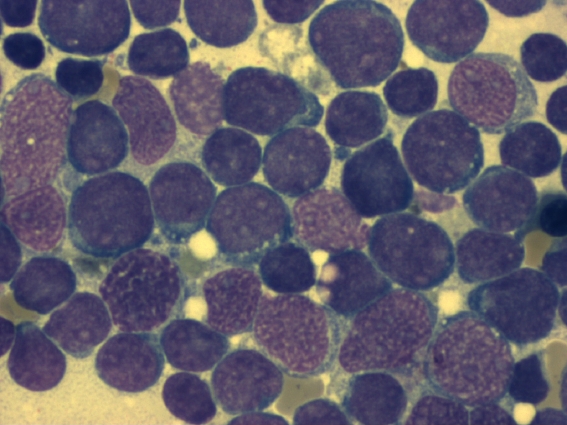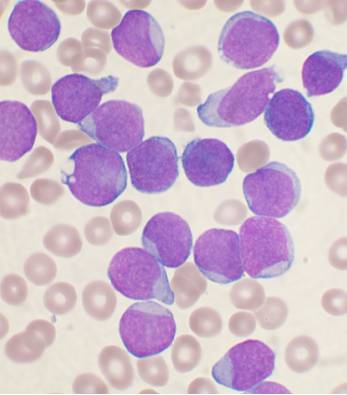WBR0158: Difference between revisions
Jump to navigation
Jump to search
No edit summary |
No edit summary |
||
| Line 28: | Line 28: | ||
[[File:Acute leukemia-ALL.jpg |thumb| none| Peripheral blood smear of patient with ALL]] | [[File:Acute leukemia-ALL.jpg |thumb| none| Peripheral blood smear of patient with ALL]] | ||
| Line 39: | Line 33: | ||
'''References:''' First Aid 2012 page 399 | '''References:''' First Aid 2012 page 399 | ||
|AnswerA=5- Fluorouracil | |AnswerA=5- Fluorouracil | ||
|AnswerAExp='''Incorrect:''' [[5-Fluorouracil]] (5-FU) is a pyrimidine analogue that inhibits thymidylate synthase. It is indicated for the treatment of a variety of adenocarcinomas and does not interact with allopurinol. | |AnswerAExp='''Incorrect:''' [[5-Fluorouracil]] (5-FU) is a pyrimidine analogue that inhibits thymidylate synthase. It is indicated for the treatment of a variety of adenocarcinomas and does not interact with allopurinol. | ||
| Line 51: | Line 44: | ||
|AnswerEExp='''Incorrect:''' [[Methotrexate]] competitively inhibits folic acid binding to Dihydrofolate reductase, an enzyme responsible for the conversion of dihydrofolic acid to the activate form, tetrahydrofolic acid. Tetrathydrofolic acid is an essential substrate for the synthesis of thymidylate, which is in turn required for DNA synthesis. | |AnswerEExp='''Incorrect:''' [[Methotrexate]] competitively inhibits folic acid binding to Dihydrofolate reductase, an enzyme responsible for the conversion of dihydrofolic acid to the activate form, tetrahydrofolic acid. Tetrathydrofolic acid is an essential substrate for the synthesis of thymidylate, which is in turn required for DNA synthesis. | ||
|RightAnswer=B | |RightAnswer=B | ||
|WBRKeyword=Cancer, Leukemia, ALL, Acute Lymphocytic Leukemia, Chemotherapy, Antimetabolite, Nucleotide, | |WBRKeyword=Cancer, Leukemia, ALL, Acute Lymphocytic Leukemia, Chemotherapy, Antimetabolite, Nucleotide, | ||
|Approved=Yes | |Approved=Yes | ||
}} | }} | ||
Revision as of 14:09, 14 October 2013
| Author | PageAuthor::William J Gibson |
|---|---|
| Exam Type | ExamType::USMLE Step 1 |
| Main Category | MainCategory::Pharmacology |
| Sub Category | SubCategory::Hematology, SubCategory::Oncology |
| Prompt | [[Prompt::A 76-year-old woman with a history of gout adequately controlled with allopurinol presents to her primary care physician for fatigue. Complete blood count reveals marked neutropenia. Bone marrow biopsy confirms the diagnosis of Acute Lymphoblastic Leukemia. Remission is induced with combination chemotherapy consisting of dexamethasone, vincristine, asparaginase, and daunorubicin. Repeat bone marrow biopsy later reveals residual disease, requiring intensification therapy. Which of the following drugs should be avoided in this patient?]] |
| Answer A | AnswerA::5- Fluorouracil |
| Answer A Explanation | [[AnswerAExp::Incorrect: 5-Fluorouracil (5-FU) is a pyrimidine analogue that inhibits thymidylate synthase. It is indicated for the treatment of a variety of adenocarcinomas and does not interact with allopurinol.]] |
| Answer B | AnswerB::6-Mercaptopurine |
| Answer B Explanation | [[AnswerBExp::Correct: 6-Mercaptopurine (6-MP) is metabolized by xanthine oxidase, the target of allopurinol. Thus, coadministration of 6-MP and allopurinol can lead to overdose of 6-MP and toxicity.]] |
| Answer C | AnswerC::6-Thioguanine |
| Answer C Explanation | [[AnswerCExp::Incorrect: 6-Thioguanine (6-TG) is an antimetabolite guanine analogue. 6-TG is converted to 6-thioguanine monophosphate by HGPRT. It inhibits DNA synthesis in a similar manner to 6-MP. However, 6-TG is safe to administer with allopurinol.]] |
| Answer D | AnswerD::Cytarabine |
| Answer D Explanation | [[AnswerDExp::Incorrect: Cytarabine is a competitive inhibitor of DNA polymerase. Upon entrance to the cell, cyatabine is converted to araCTP which can then be incorporated into a growing strand of replicated DNA, resulting in elongation termination.]] |
| Answer E | AnswerE::Methotrexate |
| Answer E Explanation | [[AnswerEExp::Incorrect: Methotrexate competitively inhibits folic acid binding to Dihydrofolate reductase, an enzyme responsible for the conversion of dihydrofolic acid to the activate form, tetrahydrofolic acid. Tetrathydrofolic acid is an essential substrate for the synthesis of thymidylate, which is in turn required for DNA synthesis.]] |
| Right Answer | RightAnswer::B |
| Explanation | [[Explanation::Acute lymphoblastic leukemia (ALL) is a hematopoetic malignancy characterized by replacement of the bone marrow by lymphoblastic cells similar to the cells pictured below. ALL is most common in childhood with a peak incidence at 2–5 years of age, and another peak in old age. Immunohistochemical analysis of tumor biopsies may reveal TdT or CALLA antigens on the surface of leukemic cells. TdT is a protein expressed early in the development of pre-T and pre-B cells, whereas CALLA is an antigen found in 80% of ALL cases and also in the "blast crisis" of CML.
ALL is typically highly responsive to chemotherapy. 6-Mercaptopurine and 6-thioguanine are commonly used drugs for consolidation therapy in these patients. 6-MP is metabolized by xanthine oxidase, the target of allopurinol. Thus, co-administration of 6-MP and allopurinol can lead to overdose of 6-MP and toxicity.  
References: First Aid 2012 page 399 |
| Approved | Approved::Yes |
| Keyword | WBRKeyword::Cancer, WBRKeyword::Leukemia, WBRKeyword::ALL, WBRKeyword::Acute Lymphocytic Leukemia, WBRKeyword::Chemotherapy, WBRKeyword::Antimetabolite, WBRKeyword::Nucleotide |
| Linked Question | Linked:: |
| Order in Linked Questions | LinkedOrder:: |